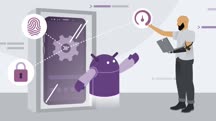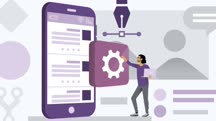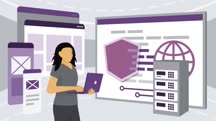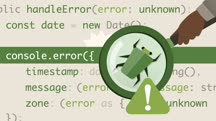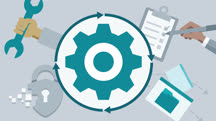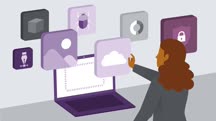Course catalog
Categories
Showing 81-100 of 1,450 items.
Analyzing a Real Estate Deal (230262)
Your success in real estate is not going to come from having lots of experience, credibility, cash, or even good people skills. It comes from knowing how to buy the right piece of real estate at the right price. So before you buy your first (or next) investment property, you need to understand precisely: how much to buy the property for, how much to sell the property for, and how much profit you're going to make as a result. When you know these numbers, it makes real estate investing a lot less risky. This course explains how to run the numbers on any property and know if you've got a deal. Learn how to analyze a lead on your phone, on your desktop, or in person; calculate the after-repair value; conduct more research via the MLS; look for market anomalies; and prepare to view homes in person and make smart deals.
This course was created by WealthFit. We are pleased to host this content in our library.

This course was created by WealthFit. We are pleased to host this content in our library.

Android 12 and Beyond: First Look for Developers (229140)
Android 12 has entered the building. This next version of Android—which is available to developers and other Android users as a beta preview—introduces notable new features and changes in both functionality and appearance. In this course, David Gassner goes over the updated operating system, showing developers both the latest and greatest features in Android 12 and other changes to development tools and best practices that will impact their existing apps. Learn what's new in Android 12 for end users, including changes to privacy and sharing. Explore developer enhancements, including the new RenderEffect class that lets you modify images in an Android app at runtime. Plus, David goes over how to migrate from older file management strategies to scoped storage—as well as the deadlines for implementing these required changes.
Android Development Essential Training: 3 Navigation (229293)
Do you want to build an application for Android? The Android Development Essential Training series teaches the basics needed to develop, design, manage, and distribute your own native Android application using the Kotlin programming language and the Android SDK. In part 3, instructor Annyce Davis teaches you how to manage lifecycle events, views at runtime, navigation, and navigation menus. Annyce shows you how to inspect and handle lifecycle events on Android, offers a refresher on Kotlin lambdas, and introduces you to ViewModels and LiveData—as well as how you can use both to add and update data. She goes into how to use Intents to communicate with other app components and navigate between activities. Annyce also covers how to display a button on a toolbar and add a navigation bar. Bottom navigation bars make it easy for users to explore and switch between top-level views in a single tap; Annyce explains how to add this to your app, complete with menu items.
Android Development Essential Training: 4 Working with Data (226386)
Do you develop Android apps? Are you wondering how to get started or wondering how to improve? This series of courses covers the essentials you must know to develop, design, and manage a native Android application. In this course, the fourth part in a four-part series, instructor Annyce Davis focuses on data, with hands-on challenges to check your understanding. Annyce explains the various types of data processing available in Android. She shows you how to package static data in JSON files, to make it easier to work with data in your application. Annyce steps through using LiveData objects, HTTP clients, a Retrofit interface, and more to get data from a web service. She discusses how you can use a RecyclerView to display different types of data in your app, then concludes by walking you through ways to display data that a user selects.
Android Development Essential Training: 5 Storage and Databases (232574)
Do you want to build an application for Android? The Android Development Essential Training series teaches the basics needed to develop, design, manage, and distribute your own native Android application using the Kotlin programming language and the Android SDK. In part 5 of this course, Annyce Davis tackles storage and databases, and how you can develop apps that take advantage of a device’s storage. She shows how to use the Android file system to store and load JSON data with Moshi, how to persist data with shared preferences, and how to manage databases with Room. To close out the course, Annyce gives one last challenge to test your knowledge.
Android Development: Data Binding (229055)
Android data binding architecture components make it easier to connect an application's data with application layouts. This eliminates an excess of boilerplate code and leads to more modular programs with greater separation of data and presentation. In this course, explore the benefits of data binding for Android developers, as well as how to enable data binding for your own app. Learn how to create a data model and add data binding support to your Android layout file. Discover how to use binding expressions to manipulate data values directly within an Android layout; bind to observable data sources to ensure that changes are automatically reflected in the layout; use binding adapters; and more.
Android Development: Retrofit with Kotlin (219229)
Many apps use your mobile phone’s internet connection to get data. On Android, the primary way that apps get and post data over the internet is with a library called Retrofit. This course shows you how to use Retrofit with idiomatic Kotlin code that you can apply directly to your Android app. Instructor Rahul Pandey covers everything you need to know to build rich, networked Android apps. Rahul starts with helping you understand APIs and their uses. He explains concurrency, coroutines in Kotlin, and how both can benefit your app. Rahul steps you through getting started with an Android Retrofit project, as well as retrieving and sending data and handling authentication in your Android app. Finally, Rahul covers several advanced configuration options related to Retrofit.
Android Studio Essential Training (218617)
Software developers who want to build Android apps need Android Studio—the official Google IDE. Android Studio is based on IntelliJ IDEA and contains the same great coding and debugging features plus lots of tools that are unique to Android development: layout editors, resource managers, virtual device support, and more. In this course, instructor David Gassner introduces Android Studio. He helps you set up your environment and your first project and provides handy shortcuts for writing and debugging code. David also shows how to add version control and share projects on GitHub, manage project dependencies, use activity and code templates, and work with Google’s preferred programming language for Android development, Kotlin. Lastly, he covers developing with Jetpack Compose, a new library that lets you build an app’s interface completely in Kotlin. By the end of the course, you should be able to use Android Studio to become a faster, even more efficient developer.
Angular: Creating and Hosting a Full-Stack Site (221558)
You've learned Angular and can create amazing front-end interfaces—but deploying them requires more than just Angular. You need logic running on the server, and a place to put that logic. If you want to apply your Angular skills to a broader range of projects—but you're not very familiar with server-side development—then this course is for you. Join instructor Shaun Wassell as he steps through how to build a full-stack, Angular-powered website from scratch. Shaun demonstrates how to create an Angular 9 front end and write a back end in Node.js using hapi. He then shows how to add MySQL to your back end, connect the front and back ends, add Firebase Authentication to your project, and move your full-stack application to the cloud.
Angular: Testing and Debugging (233169)
Errors caused by missing dependencies, undefined variables, or poorly formatted data can cause your web application to stop working. In this course, learn how to track down and eliminate these types of errors in your Angular applications through the process of testing and debugging. Instructor Derek Peruo breaks down common error messages and goes over a variety of testing and debugging options. He also covers code linting, shares some tips and tricks for avoiding pitfalls during development, and goes into writing custom error handlers to make it easier to work with errors as your application grows.
Animation Fundamentals and Careers (222459)
Animation is an exciting career path that touches all the media you use today: games, television, corporate media, even theme parks. Explore the world of animation with expert David Andrade, as he leads you through the fundamental principles, workflows, and available careers. Discover how the principles of animation—passed down by generations of pioneers—can help your work look professional and how these same principles translate to digital animation. Then review the digital animation pipeline, from modeling to lighting to rendering. Finally, find out what jobs are available in the fields of motion graphics, TV and films, games, and even the corporate world.
Ansible Essential Training (219059)
Ansible, the easy-to-use IT automation engine, can transform and optimize tasks such as rolling updates with just a few lines of code. In this course, explore intermediate to advanced use cases for using this powerful tool at scale. Instructor Anthony Sequeira shares instructions and demonstrations designed to help you master the details of Ansible playbook construction and execution. Learn how to take full advantage of Ansible by building thoughtfully designed tasks. Explore how to reuse Ansible functionality with roles, as well as comb through Ansible Galaxy to leverage content from the Ansible community. Plus, learn how to encrypt secret information, use Ansible for the management of network devices, and leverage the power of idempotence.
Ansible Essential Training (2018) (229837)
Ansible is an easy-to-use IT automation engine. It can transform and optimize tasks such as rolling updates with just a few lines of code. However, many organizations aren't using Ansible modules and playbooks in a reusable fashion; they are reinventing the wheel every time they automate. This training course introduces intermediate to advanced use cases for using the tool at scale. Instructor Robert Starmer shows how to reuse Ansible functionality with roles, encrypt secret data with Ansible Vault, support idempotence, and manage multiple groups of systems with Ansible Tower. He shows you how to string these concepts together to use Ansible in the most efficient way possible: variablizing resources, capturing your ideas into roles, and extending Ansible from simple server management to network management-and beyond.
Apache Kafka Essential Training: Building Scalable Applications (210542)
Scalable and distributed message queuing plays an important role in building real time big data pipelines. Asynchronous publisher/subscriber models are required to handle unpredictable loads in these pipelines. Apache Kafka is the leading technology today that provides these capabilities and is an essential skill for a big data professional. In this course, Kumaran Ponnambalam provides insights into the scalability and manageability aspects of Kafka and demonstrates how to build asynchronous applications with Kafka and Java. Kumaran starts by demonstrating how to set up a Kafka cluster and explores the basics of Java programming in Kafka. He then takes a deep dive into the various messaging and schema options available. Kumaran also goes over some best practices for designing Kafka applications before finishing with a use case project that applies the lessons covered in the course.
Apache Kafka Essential Training: Getting Started (210508)
One of the key components of a big data processing pipeline is a scalable and distributed message queue. Message queues enable real-time streaming capabilities with multiple producers and consumers of data. This enables real-time applications that can analyze data and produce insights in a scalable fashion. Apache Kafka provides these capabilities. As the de facto standard for open-source messaging, Apache Kafka is an essential skill for data scientists, big data engineers, data architects, and solution architects. In this course, instructor Kumaran Ponnambalam introduces Apache Kafka and explains its fundamental concepts and basic operations. Kumaran covers basic concepts like messages, topics, logs, and more. He shows you how to use the Kafka command line, as well as partitions and groups. He goes over Kafka Java programming, then concludes with a use case project.
Apache Spark Essential Training: Big Data Engineering (218685)
Data engineering is the foundation for building analytics and data science applications in the new Big Data world. Data engineering requires combining multiple big data technologies to construct data pipelines and networks to stream, process, and store data. This course focuses on building full-fledged solutions that combine Apache Spark with other Big Data tools to create end-to-end data pipelines. Instructor Kumaran Ponnambalam begins by defining data engineering, its functions, and its concepts. Next, Kumaran goes over how Spark capabilities such as parallel processing, execution plans, state management options, and machine learning work with extract, transform, load (ETL). He introduces you to batch processing use cases and processes, as well as real-time processing pipelines. After walking you through several useful best practices, Kumaran concludes with an end-to-end exercise project.
Apple Certified Support Professional macOS 11: 1 Installation and Configuration (218872)
Are you currently a macOS administrator, or do you aspire to be one? If so, this course can help you master some important basics. With a user-friendly, two-host format, ITProTV introduces you to the installation and configuration tasks that must be completed to get started in macOS. This course covers what you need for installation, how to build USB installation media for macOS, actually installing macOS, performing the initial system configuration, adding a printer to macOS, and sharing the printer on a network. This course also helps you begin your preparation for the Apple Certified Support Professional (ACSP) certification.
Note: This course was created by ITProTV. We are pleased to host this training in our library.
Note: This course was created by ITProTV. We are pleased to host this training in our library.
Apple Certified Support Professional macOS 11: 2 User Accounts (219603)
Are you currently a macOS administrator, aspiring to become one, or preparing for the Apple Certified Support Professional (ACSP) certification exam? If so, this course can help you master the information you’ll need about user accounts in macOS. With a user-friendly, two-host format, ITProTV steps you through several types of user accounts, as well as user account security and the Screen Time feature. This course covers local user accounts, iCloud accounts, and special user accounts. Then it goes into how to delete user accounts that are no longer required and how to handle the contents of their home directories. The course concludes with instructions on how to use the Screen Time feature in macOS to control a user's experience and enable, configure, and disable Screen Time for an account.
Note: This course was created by ITProTV. We are pleased to host this training in our library.
Note: This course was created by ITProTV. We are pleased to host this training in our library.
Apple Certified Support Professional macOS 11: 3 Data Management (232625)
Are you currently a macOS administrator, aspiring to become one, or preparing for the Apple Certified Support Professional (ACSP) certification exam? If so, this course can help you master information you’ll need about data management in macOS. With a user-friendly, two-host format, ITProTV shows you several methods for managing your data, keeping it secure, and setting permissions. This course covers storage hardware, file systems, and file system maintenance. It explains FileVault disk encryption and the differences between archives and disk images. The course explains default file permissions, then goes into how you can customize permissions and set special file permissions. After going over aliases, links, and hidden files and folders, the course concludes with the four file domains in macOS and the purpose of each domain.
Note: This course was created by ITProTV. We are pleased to host this training in our library.
Note: This course was created by ITProTV. We are pleased to host this training in our library.
Apple Certified Support Professional macOS 11: 4 Applications and Processes (219586)
The Apple Certified Support Professional (ACSP) certification confirms your understanding of the core functionality of macOS, as well as your ability to configure key services, perform basic troubleshooting, and support multiple users with essential macOS capabilities. In the fourth installment of this course from ITProTV, Don Pezet and Zach Memos cover applications and processes in macOS 11. Don and Zach look at the Apple App Store, as well as the different methods for installing applications and the pros and cons of each approach. They also address application security, how to customize your preferences, how to use and add features to Quick Look, and the different methods of voice control you can use in macOS.
Note: This course was created by ITProTV. We are pleased to host this training in our library.
Note: This course was created by ITProTV. We are pleased to host this training in our library.

